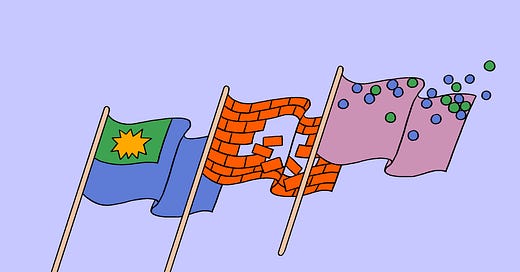Last month, the analyst Ben Thompson quietly marked a milestone: 10 years since he turned on paid subscriptions for his one-man publication, Stratechery.
That milestone has significance to Substack for two reasons.
The first is that the business model that Ben devised for Stratechery inspired the earliest version of Substack. At that time, in 2017, Ben would publish one free weekly article on stratechery.com and then offer readers three more posts a week by email if they subscribed for $100 a year or $10 a month. He accepted no advertising and considered his subscribers his customers. Ben was clearly very successful with that model—Substack CEO Chris Best and I calculated that he was making a seven-figure income from a spare bedroom in his Taipei apartment—and frequently said that more writers should try it. We wondered why more didn’t.
One of the common excuses at the time was that Ben was writing about the technology industry for investors and executives who, of course, wouldn’t think twice about paying to subscribe to a newsletter but that his approach wouldn’t work for other areas. That didn’t sound right to us. Why would this model work for tech but not, say, finance? Or even politics? People were getting used to paying for content online—Netflix and Spotify were well established, Patreon was on the rise—and niche expertise was becoming increasingly valuable in a world where, thanks to social media, we were being flooded with cheap pabulum.
We guessed that perhaps the biggest reason more writers didn’t do what Ben was doing was just that it was hard. Ben had strapped together various tools, like WordPress, Mailchimp, and Memberful, to constitute Stratechery’s “stack”—we counted 19 tools in total—and it took a lot of work to make them play well together. We wondered what would happen if we made it one-click easy for any writer to try the Stratechery model for themselves. What if a writer could go to a web page, type into a box, click “publish,” and then have money from their readers magically appear in their bank account?
In October 2017, we tested the idea with my friend
, who had been publishing a free newsletter about China, Sinocism, for about five years. On the day Bill went live with paid subscriptions on this new thing called Substack, he reached six figures in revenue. The idea worked. hasn’t stopped growing since, and tens of thousands of other writers have followed. Seven years on, there are now more than 3 million paid subscriptions to Substack publications.The age of the “sovereign writer,” as Ben would later describe it, had begun.
Making the internet work for creators
The second reason why Ben’s milestone is significant is that he, better than anyone else, has identified and articulated the force that has overwhelmingly shaped online media over the past decade: Aggregation Theory.
Ben’s theory describes how and why a few major platforms have come to dominate the flow of information and entertainment—and the associated economies—online.
An aggregator like Facebook or Airbnb brings all the relevant goods, services, or information that a consumer might seek into one place, and it gathers all the consumers there, too. Netflix is a one-stop shop for film and television. YouTube is a one-stop shop for user-generated video. Uber is a one-stop shop for car rides. These aggregators amass attention and then monetize accordingly. In online media, the money has come mostly through advertising (Facebook, Instagram, Twitter, TikTok) and platform subscriptions (Spotify, Netflix, YouTube Premium). Crucially, the aggregators own the relationships with the users, even if those users primarily show up because they care most about the people who produce something of value within the aggregator’s system.
There are some immense advantages for creators in these kinds of systems. Since the aggregators have brought everyone to one place, creators have the chance to reach people in huge numbers, and in many cases—especially when their products are digital—they don’t have to pay for distribution. You can publish a photo on Instagram and, if the algorithm’s winds blow just right, within minutes it can reach millions of people around the world.
But there are also some pretty serious disadvantages. By definition, there can be only so many aggregators—only so many Instagrams, or Amazons, or TikToks. As they grow, the aggregators that rise to the top become so successful that they ultimately squeeze out competition. Because of that enormous distribution power, the vast majority of new internet businesses must play by the aggregators’ rules, which includes accepting that the aggregators control the relationships with the customers.
This dynamic also makes those businesses extremely vulnerable to any changes or priority shifts enacted by the ruling bodies. One famous example of this uncomfortable dependency is BuzzFeed, which rose to prominence through its savvy use of Facebook in the early 2010s but has been in decline ever since the social network decided to deprioritize news. By the same token, MrBeast is a giant YouTube success story, but even he remains subject to any C-suite decisions that might result in the down-ranking or demonetization of certain types of content that, for whatever reason, YouTube might deem less desirable in a given moment. Everyday creators are also affected. The dominant feeds are becoming more and more like TikTok, which prioritizes compelling “For You” content over relationships between creators and their followers. A large Instagram following doesn’t mean what it once did.
The Aggregation Era has thus birthed significant new economies, but it has also given the individuals and small teams who rule these platforms almost godlike powers. Today, for good or ill, the fate of the vast majority of the world’s creators rests in the hands of Mark Zuckerberg, Elon Musk, Sundar Pichai, and the Chinese Communist Party.
But that simple model that Ben came up with for his one-man publication is a crack in the dam. We are now seeing the beginning of an economic and technological shift that will reshape the media economy. Writers and creators are branching out from old institutions and building new online properties where they are in charge. These creators have found not only more freedom and autonomy but also a stable income. The top writers on Substack earn millions of dollars a year.
This shift has the potential to correct a power imbalance that, in the internet’s primitive commercial era, has delivered tremendous benefits to platform owners while leaving creators to hustle, struggle, and pray for scraps. This shift is happening not because of a smarter algorithm, the arrival of a more callous kingpin, or some kind of government intervention—it’s happening because of the rising demand that creators must have ownership of their audiences.
If you control your relationship with your audience and can reach them directly, then a fickle autocrat can’t nuke your work with the tap of a button. Even better: if that audience is paying you directly, then you don’t have to cross your fingers and hope that the advertising market happens to be enjoying fair weather, or that a particular corporation’s McKinsey-driven marketing priorities have determined that it is desirable to attach its name to yours this quarter. You can make money from subscriptions without needing to amass a mammoth or perfectly targeted, ad-friendly audience, and without needing to answer a single sales email. The way to grow your subscription revenue is the same way you produce your best work: by spending almost all your time focusing on the work itself.
I spend a lot of time telling people that Substack’s real product is its business model. It is a model that is, by careful design, friendly to creators. On Substack, the creators own their relationship with their audience—captured in a mailing list that they control—and all their content, which they can export anytime they want. The creator holds onto the vast majority of the financial value generated on the platform: Substack gets 10%, and the creator gets 90%. We only make money when they make money. Imagine how much money creators could have made in the past couple of decades if the work they did on Facebook, Instagram, Twitter, and TikTok resulted in their getting 90% of the advertising revenue that those platforms instead keep for themselves.
This deal also puts the onus on the platform. To survive as a business, Substack must put itself in service of creators; we must keep proving our value to them. Because if we don’t? They can simply pack up and leave, in search of a better deal elsewhere. Indeed, to some business analysts (including, ironically, Ben Thompson), this approach leaves Substack too vulnerable to losing creators. What this critique misses, however, is that there are now enough examples of creators enjoying financial success and true independence for others to feel more comfortable demanding control. They don’t want to be stuck in a digital Hotel California, where they can log in anytime they like but never leave. For a platform of the post-Web 2.0 era to succeed, it will need to keep creators’ trust by guaranteeing their ownership. It’s the way things should be. Platforms should not own people; people should own platforms.
The challenge, or opportunity, for companies like Substack is to figure out how to help creators reach new audiences and grow without having to compromise on ownership. The aggregators of the early internet unlocked great power for creators through building central gathering places. We are doing the same with the Substack app and features—like Recommendations and Notes—that facilitate cross-promotion, cross-pollination, and discovery while keeping creators in control. Today, the Substack network accounts for more than 25% of all paid subscriptions on the platform—the kind of free growth that we hope makes 10% feel like a bargain.
This new model takes what we have learned from the Aggregation Era and finds a way to blend it with the independence enjoyed by the “sovereign writer”—or, to be appropriately expansive, let’s call it “sovereign creator.” It is, I believe, the natural model of the internet, taking advantage of the web’s massive scale and interconnectivity and merging it with the exhilarating power of true ownership.
The sovereign creators will take their best work and most valuable audiences to places like Substack, even if they continue to use the aggregators for shallower engagement with mass audiences. In effect, the likes of Facebook and TikTok will become marketing channels for creators, who will consider those platforms to be valuable only for as long as they continue to do that job well. This arrangement is a key inversion of the prevailing power relationship: the internet starts working for creators rather than the other way around.
Ben hasn’t written much about the sovereign creator, but I hope he and others will dive deeper. He is, after all, one of the pioneers of the form. Over the course of the past decade, he has shown how Aggregation Theory has characterized and ruled this era of the internet. But the next decade will be about taking the lessons from that era and applying them to the realm of the sovereign creator. The companies and technologies that best serve those creators will be the ones that facilitate the best relationships, the best content, and the best communities on the internet.
Anything that takes the power and wealth that was previously concentrated in the hands of a few and distributes it instead to millions of the world’s most creative minds is a step forward for society. My bet is that the Sovereign Creator Era will be better than the Aggregation Era—not just for creators but for everyone.







Share this post